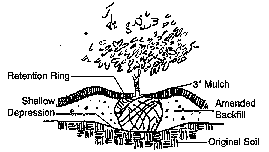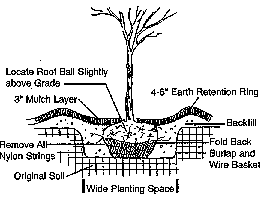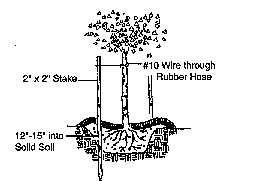
Prepared by:
M.A. Powell
Horticulture Specialist
T.E. Bilderback
Horticulture Specialist
T.M. Disy
Extension Information Specialist
Published by: North Carolina Cooperative Extension Service
Publication Number: AG 508-4
Last Electronic Revision: March 1996 (JWM)
A properly planted tree or shrub will be more tolerant of adverse conditions and require less management than one planted improperly. Planting technique has an impact water quality, because it minimizes water, fertilizer and pesticide use. When making decisions on planting techniques, one should consider how the plant was grown in the nursery, the plant's drainage requirements, the soil type and drainage characteristics, and the availability of irrigation water. The plant should be appropriate to the specific site, or the site should be physically amended to fit the specific plant.
The Challenge: Horticulture researchers have estimated that 90 to 95 percent of the roots may be lost when digging field-grown nursery stock. Cultural practices by the nurseryman, such as root pruning, irrigation, fertilization, root-ball configuration, and digging techniques influence the percentage of harvested roots. Water stress, caused by the removal of very small roots that absorb most of the plant's water, is the primary cause of transplant failure. These fragile roots are the first to suffer from excess water loss in newly transplanted landscape plants.
Sources of Plant Material: Landscape contractors and home gardeners can choose from a wide variety of plant material in North Carolina. Plants are grown by various production methods, such as bare-root, balled and wrapped in burlap, fabric container, and plastic container. Some large landscape trees are mechanically dug with a tree spade and placed in wire baskets. Each of these harvesting and growing techniques is acceptable but requires a specific planting and management technique. Planting dates and specific-site environmental conditions for each method will determine the water and nutrient efficiency. For example, balled-and-burlapped plants will require much less additional water to ensure transplant success if they are planted between November and February, as compared to planting in late spring and summer.
Bare-Root Plants: Advantages of planting bare-root plants are mostly economical. Plants are less expensive to produce because of the ease of harvesting, storing and shipping. Many deciduous species respond well to bare-root harvesting. A greater portion of roots are retained after harvesting, and roots are easily inspected at planting time. Damaged roots can be trimmed and girdling roots can be removed before planting. Bare-root plants should be planted while they are completely dormant. Landscape-sized bare-root trees usually require staking.
Balled-and-Burlapped Plants: Larger landscape plants are traditionally harvested as "balled-and-burlapped" (B&B). A major advantage of B&B plants is that soil types can be matched, thereby reducing any interface problems that might inhibit water and nutrient movement between the root ball and surrounding soil. The American Standard for Nursery Stock is the acceptable, standardized formula for sizing root balls. The main disadvantage of B&B material is that a large portion of the roots will be severed at harvest time. The amount of roots harvested depends on soil type, irrigation practices, and root pruning during the production period. Plants moved B&B are subject to seasonal constraints. The most favorable times to move the plants are when transpiration demand is low and root generation potential is high, such as in fall, winter, and early spring. With the much-reduced root system, water is the critical element in the successful transplanting of B&B material.
Transplanting large trees results in an extreme imbalance of root:shoot ratio. When a major portion of the roots is lost, the capacity to absorb water from the soil is reduced proportionally. Research shows that it takes as long as 2 months for new roots to be initiated from the callus formed after the root was severed. It can be as long as 3 months before the regenerated roots absorb moisture outside the root ball, and at least 5 months until soil moisture is absorbed at the similar rates from the root ball and the backfill soils. As the root system expands, top growth (crown) will continue to increase. When the root system has grown back to its original ratio, normal crown vigor will return. Most studies indicate that the period of reduced vigor following transplanting will last about one year per each inch trunk caliper. (It will take a 3-inch transplanted tree three years to regain original root:shoot ratio.) During this time, additional nitrogen should be limited so that additional shoot growth will not be encouraged at the expense of root growth.
Container-Grown Plants: The advantage of using plants grown in containers is that 100 percent of the roots are in the container. Thus, the plant goes through limited transplant shock if given adequate follow-up care. Container-grown plants can be planted into the landscape year-round. Plants produced in containers in a soilless medium (usually bark and sand) are much lighter than B&B material. This is helpful to home gardeners who may not have large equipment to handle heavy plants.
The main disadvantage of container-grown plants is the possibility of deformed roots. "Rootbound" plants have roots circling inside the container. The entangled roots are a physical barrier to future root growth and development. If this condition is not corrected by loosening the root mass at planting time, the plant may experience slow growth and establishment because of the girdled roots.
A relatively new nursery production system involves the use of fabric containers or bags. Plants are grown in the bags and placed in the ground with a soil backfill. An advantage of this production technique is purported to be a means of harvesting a greater number of roots while using field-production practices. The fabric must be removed at transplanting time. This can be somewhat of a problem when the roots have become attached to the walls of the bag or if roots have escaped through the fabric.
What Size Plant Should You Choose? Small plants establish faster than large plants and are more economical. Many consumers, however, want the "instant" landscape look that you get by planting larger plants. Demand for large, landscape-size trees has certainly increased over the last decade. With large, mechanical digging equipment, 6- to 8-inch trunk diameter trees can be moved. These large trees may achieve the instantaneous effect, but post-transplant stress and costs increase with the size of the tree.
Planting Procedures: Correct planting technique begins with loading the plant at the nursery or garden center. Home gardeners and landscapers should be very careful with plant material. Here are a few important considerations:
The Planting Hole: A current trend in landscape design is to plant trees and shrubs in large beds.
When this design concept is followed, preparation of the entire plant bed area, and not just individual holes, is recommended. In many urban areas, gardeners will find that the soils are compacted and sometimes poorly drained. In these situations, create a good root-zone area by amending the beds with a sandy-loam topsoil to raise the elevation of the bed, and till the soil as deep as possible. The addition of organic matter provides little or no advantage to the planting hole in good soils. Backfill should, in most cases, be the soil removed from the planting hole: "What comes out . . . goes back in." This is especially important for B&B material and bare-root planting stock. An exception to this would be where entire beds can be amended to create an homogeneous root zone. The organic matter, such as compost or composted pine bark, is uniformly mixed with the soil. This makes room for future growth and increases aeration of the backfill.
In very poorly drained soils, it is necessary to install drain tile under the beds. If a French drain or tile drain is installed, be sure that it drains downhill at a 2 percent minimum slope and there is an outlet on the downhill side. This drainage system, in effect, lowers the water table in the planting area. When setting plants, be certain to plant them high. If the poor drainage cannot be corrected, do not plant a tree or shrub in the area unless it can tolerate these saturated soils.
If the soil is sandy and moisture is difficult to hold, a heavier topsoil can be added. In this situation, organic matter will be valuable, as it improves the water-holding capacity of the sandy soil. After planting, add a 3- to 4-inch layer of organic mulch on the soil surface around the plant. This will conserve moisture, discourage weeds, and moderate soil temperatures. Also be sure to consider the aesthetics of the mulch (see Figure 1). Landscape fabric would also be beneficial in this situation.

The most important consideration in planting trees and shrubs is the planting depth. Don't plant too deep. It is better to plant in a raised manner so the roots will not drown or suffocate. Dig planting holes two to three times as wide as the root ball and the same depth as the root ball. Locate the root ball on solid soil and not on loose backfill. Wire baskets do not need to be completely removed from large field grown trees. Cut and fold down the top half of the basket, fold back the burlap, and remove the nylon strings. Be sure to remove plastic liners or synthetic burlap-type materials.
For the most efficient use of water, construct an earthen dam 4 to 6 inches high around the drip-zone area of the plant after planting. Water will collect in this saucer and move slowly down into the planting hole area. Runoff will be minimized (Figure 2).

Wrapping, Staking, and Pruning: Trunk wraps, in theory, help prevent sunscald and cracks on thin-bark trees such as maple and birch. Tree wraps may offer some protection from rodents and maintenance equipment. Recently, however, this practice has been questioned. These injuries are usually winter injuries due to extreme environmental conditions. Trees in exposed sites, where trunks are open to south and southwest direct winter sun, may require protection. The decision on whether to apply a tree wrap should be made on a tree-by-tree basis.
Sometimes a newly planted tree will require additional support, anchorage or protection. Stakes should be added for one of these reasons, although an unstaked tree grows faster than a staked one. Prolonged staking not only reduces the taper of the trunk, but also creates the possibility of personal injury, particularly if it is not clearly flagged. Trees that were staked in the nursery may require additional support once they are transplanted. Trees planted in open, windy sites may require staking (see Figure 3). Large, transplanted trees may require heavy gauge guy wires (guying), especially evergreens such as magnolia or cedar. Follow-up management of the wires attached to the tree trunk is mandatory. Girdling can become an irreversible problem if wires are left more than one growing season. Recently planted small trees can benefit from stakes placed around them as a protection method. When they reach sufficient size, the stakes can be removed. There are no wires attaching the stakes to the trees when used for protection. A 3- to 4-inch layer of organic mulch applied approximately 3 to 5 feet around the base of the tree also offers protection from mechanical equipment.

Traditionally, B&B transplanted trees and shrubs have been pruned at transplanting time, but this practice has been amended. The traditional rationale was that reducing the top by 25 to 40 percent compensated for root loss and would result in better tree survival. Pruning should be done to remove damaged branches and to improve the structure of the plant. Overlapping, parallel and crowded branches should be pruned after installation. Cosmetic pruning, to improve the form and shape of the plant, is also recommended. Supplemental irrigation is critical to the survival of the transplanted materials.
Numerous factors should be considered when selecting and planting ornamental plants. Decisions about the size, type of plant, and planting technique should be site-specific. Correct choices and proper horticultural techniques used at this stage will eliminate or reduce the need for future supplemental irrigation.
Distributed in furtherance of the Acts of Congress of May 8 and June 30, 1914. Employment and program opportunities are offered to all people regardless of race, color, national origin, sex, age, or disability. North Carolina State University, North Carolina A&T State University, U.S. Department of Agriculture, and local governments cooperating.
AG-508-4